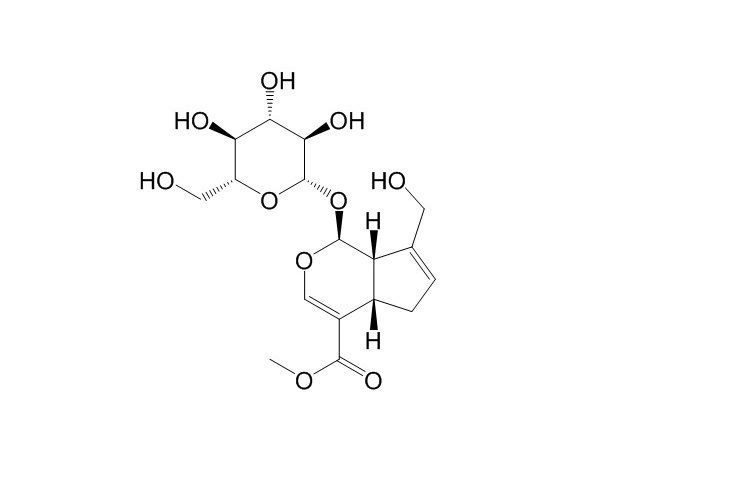Home
Products
Geniposide



| Product Name | Geniposide |
| Price: | $15 / 20mg |
| Catalog No.: | CN03163 |
| CAS No.: | 24512-63-8 |
| Molecular Formula: | C17H24O10 |
| Molecular Weight: | 388.4 g/mol |
| Purity: | >=98% |
| Type of Compound: | Iridoids |
| Physical Desc.: | Powder |
| Source: | The fruits of Gardenia jasminoides Ellis. |
| Solvent: | DMSO, Pyridine, Methanol, Ethanol, etc. |
| SMILES: | OC[C@H]1O[C@@H](O[C@@H]2OC=C([C@@H]3[C@H]2C(=CC3)CO)C(=O)OC)[C@@H]([C@H]([C@@H]1O)O)O |
| Contact us | |
|---|---|
| First Name: | |
| Last Name: | |
| E-mail: | |
| Question: | |
| Description | Geniposide is an iridoid glucoside extracted from Gardenia jasminoides Ellis fruits; exhibits a varity of biological activities such as anti-diabetic, antioxidative, antiproliferative and neuroprotective activities. |
| In Vitro | Geniposide exhibits a variety of activities, such as on antithrombosis, anti-inflammation, anti-diabetes, anti-atherosclerosis, antidepression, healing Alzheimer’s disease (AD), anti-hypertension, toxicology, and untoward reaction are summarized[1]. Geniposide markedly declines the production of IL-8, IL-1β and MCP-1 in OGD-induced brain microvascular endothelial cells, the expression of P2Y14 receptor is significantly down-regulated, the phosphorylation of RAF-1, MEK1/2, ERK1/2 are suppressed[2]. |
| In Vivo | Geniposide (200 and 400 mg/kg) significantly decreases the blood glucose, insulin and TG levels in diabetic mice in a dose-dependent manner. This compound also decreases the expression of GP and G6Pase at mRNA and immunoreactive protein levels, as well as enzyme activity[3]. Geniposide (20.0, 40.0, or 80 mg/kg) significantly reverses the excessive, alcohol-induced elevation in both serum ALT/AST and hepatic LPO levels. Geniposide upregulates the expression of heme oxygenase-1 (HO-1) to attenuate the cell apoptosis induced by 3-morpholinosydnonimine hydrochloride (SIN-1) in primary cultured hippocampal neurons[4]. Geniposide inhibits photochemistry-induced thromboembolism model in vivo. Geniposide are very effective depressants on NF-κB by interrupting IκB degradation[1]. |
| Cell Assay | The third passages of brain microvascular endothelial cells (BMECs) are used for the experiment. The BMECs are divided into four groups: (1)normal control group: the normal cultured BMECs without treatment; (2)OGD group: the BMECs injured by OGD according to the above method; (3) geniposide group: the OGD-injured BMECs treated with 33.2 μg/mL geniposide for 6 h; (4)PTX group: the OGD-injured BMECs administrated with 100 ng/mL PTX. PTX, known as an inhibitor of Gi-coupled receptor is used to assess the activation of P2Y14 receptor induced by OGD in this experiment[2]. |
| Animal Admin | Mice: Type 2 diabetic mice, induced by a high-fat diet and streptozotocin injection, are treated with or without geniposide for 2 weeks. Blood glucose levels are monitored by a glucometer. Insulin concentrations are analyzed by the ELISA method. Total cholesterol (TC) and triglyceride (TG) levels are measured using Labassay kits. Activities of hepatic GP and G6Pase are measured by glucose-6-phosphate dehydrogenase-coupled reaction. Real-time RT-PCR and Western blotting are used to determine the mRNA and protein levels of both enzymes[3]. |
| Density | 1.5±0.1 g/cm3 |
| Boiling Point | 641.4±55.0 °C at 760 mmHg |
| Flash Point | 231.5±25.0 °C |
| Exact Mass | 388.136932 |
| PSA | 155.14000 |
| LogP | -1.92 |
| Vapour Pressure | 0.0±4.3 mmHg at 25°C |
| Storage condition | ?20°C |